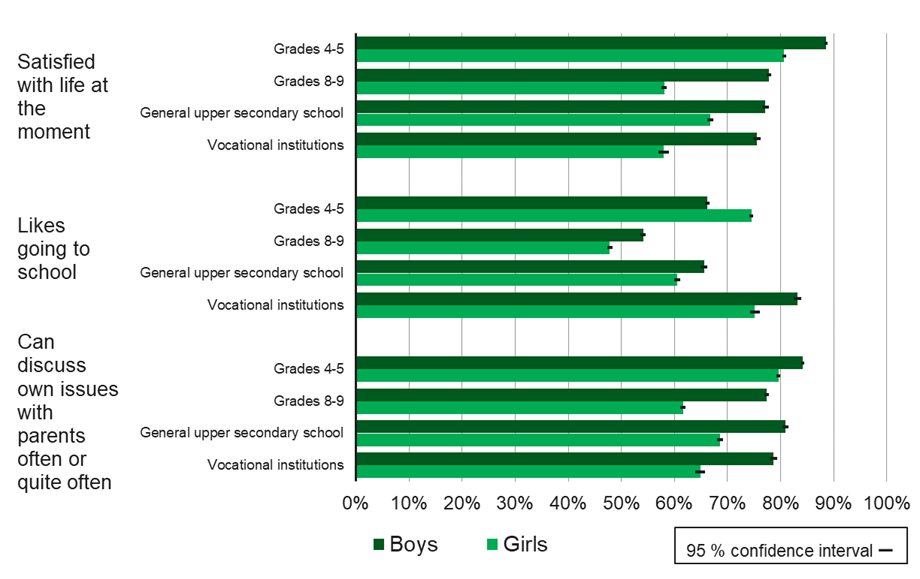Well-being of children and young people – School Health Promotion Study 2025
More children and youth find their health to be good and can often discuss their matters with parents
A large proportion of children and young people (58-89%) were satisfied with their lives. Students in grades 4 and 5 of basic education were more commonly satisfied with their lives than students in grades 8 and 9 of basic education and students in upper secondary education. Boys were more commonly satisfied with their lives than girls. The share of young girls satisfied with life increased since 2023.
It was most common for students in grades 4 and 5 of basic education (boys 66% and girls 74%) and 1st and 2nd-year students of vocational institutions (boys 83% and girls 75%) to like studying. Approximately one half of students in grades 8 and 9 of basic education and approximately two thirds of 1st and 2nd-year students in general upper secondary education liked studying.
A large proportion of children and young people (62–84%) felt that they could discuss their personal matters with their parents often or fairly often. Boys felt this way more often than girls.
The School Health Promotion study produces monitoring data every second year on the perceived health and well-being of children and young people, and their lifestyle, schoolwork and studying. This statistical report discusses the main results related to health and well-being for the year 2025, based on the responses of 269,899 children and young people. This statistic replaces the previous separate statistics on the Well-being of children and young people and on the Daily life of young people.
Download the full statistical report

Tables
Background information
- Quality report
- Privacy notice
- Data description (Aineistokatalogi, in Finnish)
- Data collection
- Previous statistical report (2023)
Description of statistics
Statistics Well-being of children and young people are based on the results of the School Health Promotion study in 2006-2025. The next data collection of the School Health Promotion study will be carried out in 2027.
The information is collected from
- students in grades 4 and 5 of basic education,
- students in grades 8 and 9 of basic education,
- 1st and 2nd-year students of general upper secondary schools and vocational institutions.
The data is collected anonymously. Children and young people fill in an electronic questionnaire at school during a lesson.
The School Health Promotion study produces monitoring data every second year on the perceived health and well-being of children and young people, and their lifestyle, schoolwork and studying. The data can be utilised in the health promotion activities for children and young people and their families. It can also be used in the development of teaching and social and health care services.
Source
Lasten ja nuorten hyvinvointi – Kouluterveyskysely 2025
Välbefinnandet bland barn och unga – Enkäten Hälsa i skolan 2025
Well-being of children and young people – School Health Promotion study 2025
Statistical report 46/2025, 17.9.2025. THL.
More information
Jenni Helenius
tel. +358 29 524 8406
Hanne Kivimäki
tel +358 29 524 7281
E-mail address: [email protected]



